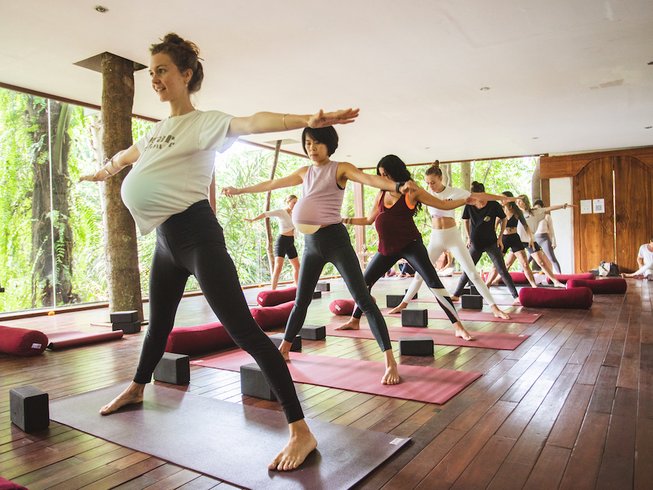Pregnancy is a beautiful yet transformative journey that brings joy, challenges, and significant changes to a woman’s body and mind. For expectant mothers, maintaining physical health, reducing stress, and preparing for childbirth are essential. Prenatal yoga has emerged as a trusted practice that helps mothers-to-be embrace this phase with strength, calmness, and confidence. Prenatal yoga in Canada is increasingly popular, with classes available in yoga studios, community centers, and even online platforms. If you are a beginner considering prenatal yoga, this article will guide you with essential tips to start your practice safely and effectively.
What Is Prenatal Yoga?
Prenatal yoga is a form of yoga specifically designed for pregnant women. It focuses on gentle stretching, breathing exercises, relaxation, and poses that prepare the body for labor and delivery. Unlike traditional yoga, prenatal yoga avoids intense movements or positions that put strain on the abdomen and instead emphasizes safety, balance, and comfort.
Practicing prenatal yoga under the guidance of a certified instructor in Canada ensures that movements are tailored to your trimester and health condition. Many instructors are trained to provide modifications for various stages of pregnancy, making the practice inclusive and supportive.
Benefits of Prenatal Yoga
Before diving into the tips, it’s worth highlighting why prenatal yoga has become such a valuable resource for expectant mothers:
Improves Flexibility and Strength
Gentle yoga poses strengthen the pelvic floor, hips, and lower back, supporting the body as it adjusts to the growing baby.
Encourages Better Breathing
Breathing exercises help mothers manage stress and improve lung capacity, which is especially helpful during labor.
Enhances Relaxation and Sleep
Prenatal yoga promotes mindfulness and relaxation, which can ease anxiety and improve sleep quality.
Relieves Common Pregnancy Discomforts
Back pain, swollen ankles, and fatigue are common issues. Gentle stretching and movement can provide relief.
Creates Community and Support
Many prenatal yoga classes in Canada foster a sense of community, allowing mothers to share experiences and advice.
Tips for Beginners Starting Prenatal Yoga
If you are new to yoga and considering it during pregnancy, here are some beginner-friendly tips to make your practice safe and enjoyable.
1. Consult Your Healthcare Provider First
Before enrolling in a class or starting online sessions, talk to your doctor or midwife. Every pregnancy is unique, and your healthcare provider can advise whether yoga is suitable for you, particularly if you have any high-risk conditions.
2. Choose the Right Class
In Canada, you will find yoga classes tailored specifically for prenatal care. Look for certified instructors who specialize in prenatal yoga. Many studios in cities like Toronto, Vancouver, and Calgary offer group sessions, while smaller communities often have online options. Ensure that the class focuses on safety and modifications suitable for beginners.
3. Invest in Comfortable Gear
Loose, breathable clothing is ideal for prenatal yoga. A supportive yoga mat, bolster, and cushion can make poses more comfortable. In colder parts of Canada, you may also want a cozy layer for relaxation segments of the class.
4. Start Slowly and Listen to Your Body
As a beginner, do not push yourself into challenging poses. Prenatal yoga is not about achieving perfection—it’s about honoring your body’s current state. If something feels uncomfortable, stop immediately and ask your instructor for modifications.
5. Focus on Breathing
Breathing exercises (known as pranayama) are central to prenatal yoga. Techniques like deep belly breathing and slow exhalations help calm the mind and prepare you for labor. Practicing mindful breathing also improves oxygen supply for both you and your baby.
6. Modify Poses for Safety
Some traditional yoga poses are not suitable during pregnancy. For example:
Avoid lying flat on your back after the first trimester, as it may restrict blood flow.
Deep twists and intense backbends should be skipped.
Inversions (like headstands) are generally not recommended for beginners.
Your instructor will guide you toward safe alternatives such as gentle squats, supported stretches, and side-lying relaxation poses.
7. Hydrate and Take Breaks
Pregnancy increases your body’s hydration needs. Keep a water bottle nearby and take breaks whenever necessary. Unlike vigorous workouts, prenatal yoga should leave you refreshed, not exhausted.
8. Practice Regularly but Gently
Consistency is more important than intensity. Attending two to three classes per week or practicing at home for 20–30 minutes daily can make a significant difference. Even short sessions of mindful breathing and stretching can be beneficial.
9. Use Props for Support
Yoga blocks, bolsters, and pillows are not just for advanced yogis—they are especially helpful for prenatal yoga beginners. They provide stability, reduce strain, and make poses more comfortable.
10. End with Relaxation
Prenatal yoga often ends with relaxation or meditation. This practice allows you to connect with your baby, release tension, and enjoy moments of peace. Visualization techniques—like imagining a calm birthing experience—can also help prepare mentally for childbirth.
Finding Prenatal Yoga Classes in Canada
The availability of prenatal yoga classes across Canada makes it easy for beginners to get started. Here are some options to explore:
Yoga Studios: Many studios in major cities offer dedicated prenatal programs.
Community Centers: Affordable and beginner-friendly classes are often hosted in community spaces.
Online Platforms: If you live in remote areas, online prenatal yoga classes led by Canadian instructors can be an excellent choice.
Private Sessions: Some expectant mothers prefer one-on-one sessions for personalized attention and comfort.
Safety Reminders for Beginners
Always inform your instructor about how far along you are in your pregnancy.
Avoid overheating; ensure the room is well-ventilated.
Pay attention to warning signs like dizziness, pain, or shortness of breath—stop immediately if they occur.
Remember that yoga is not a replacement for medical care but a complementary practice to support overall well-being.



